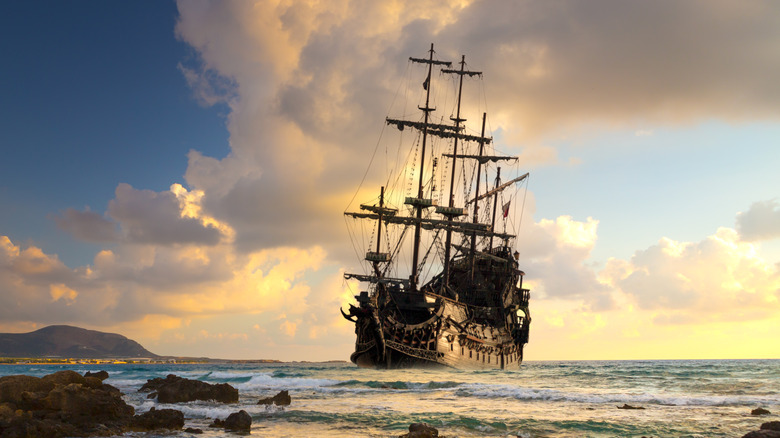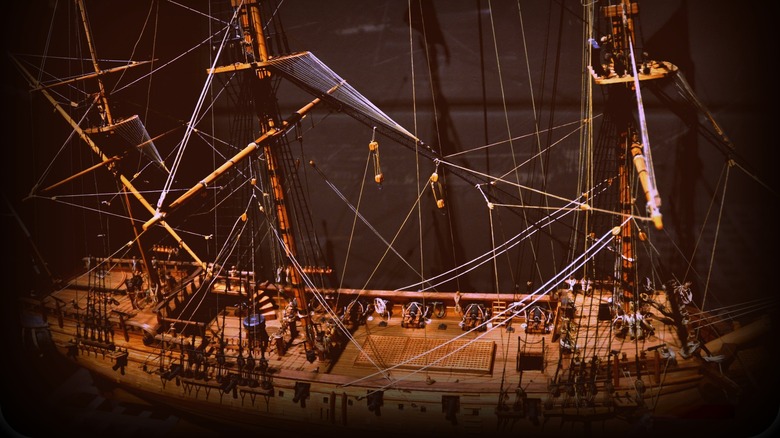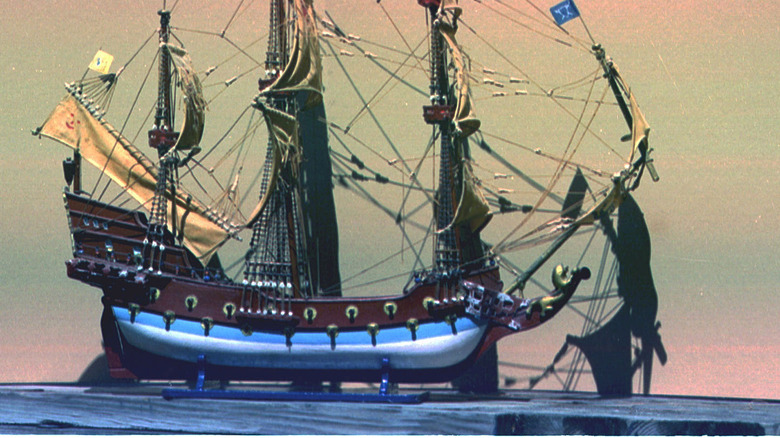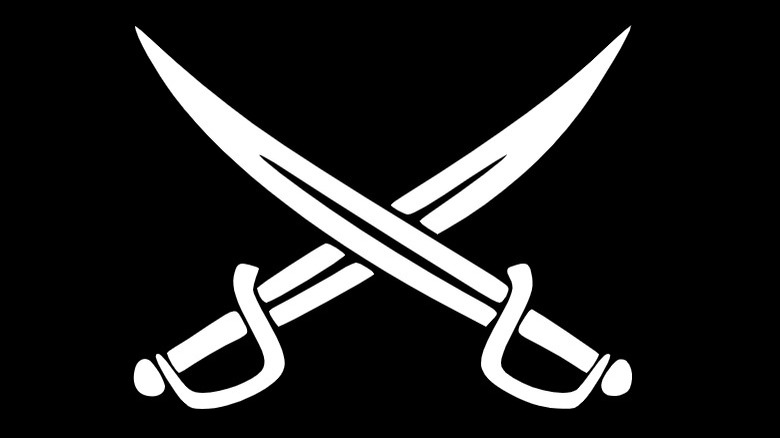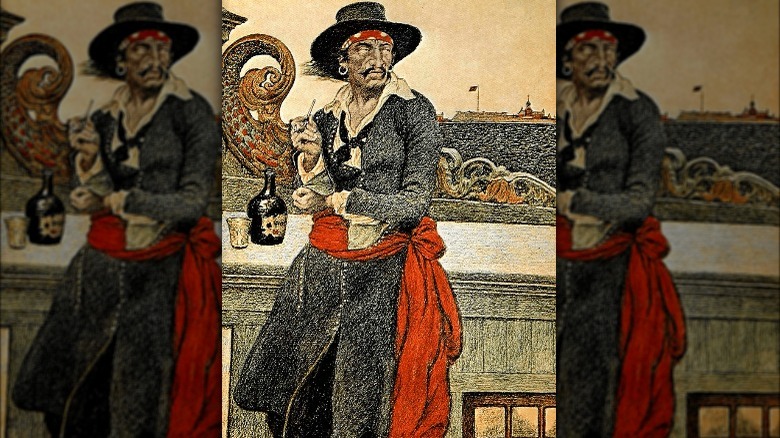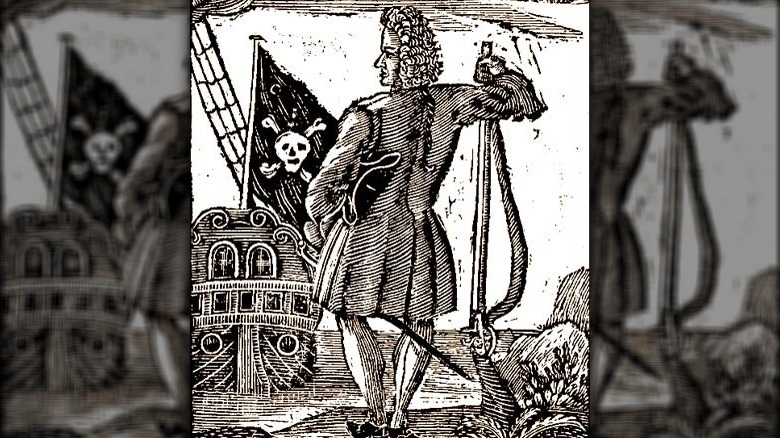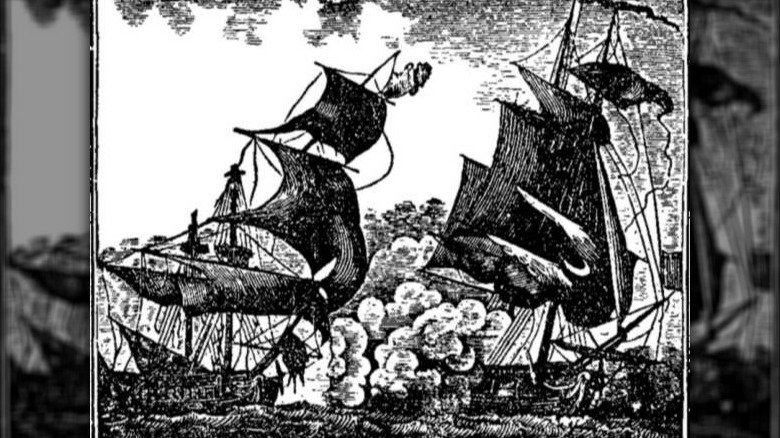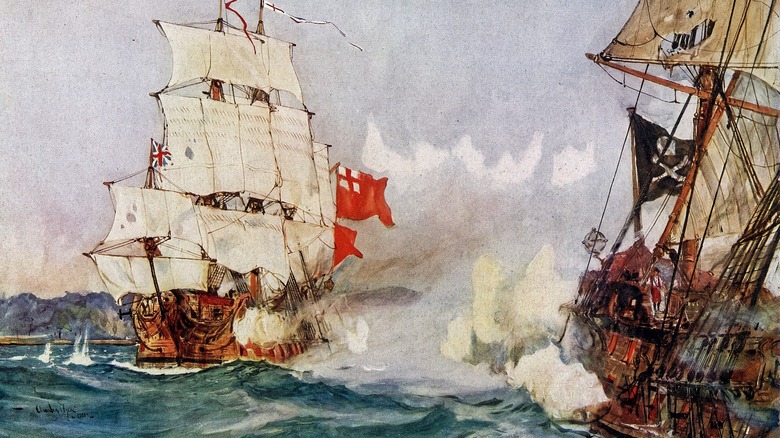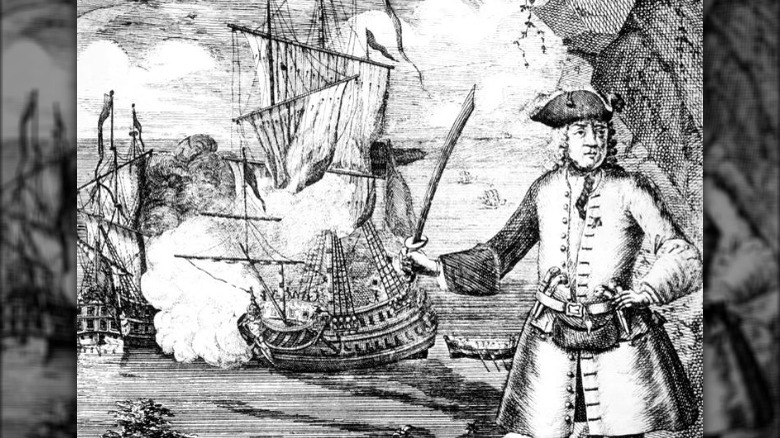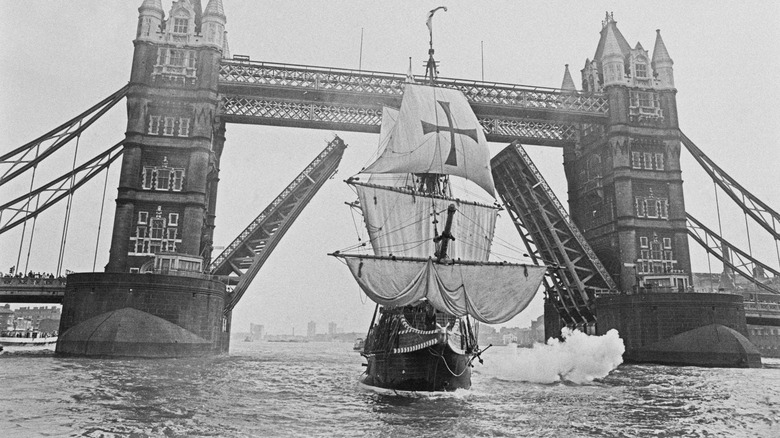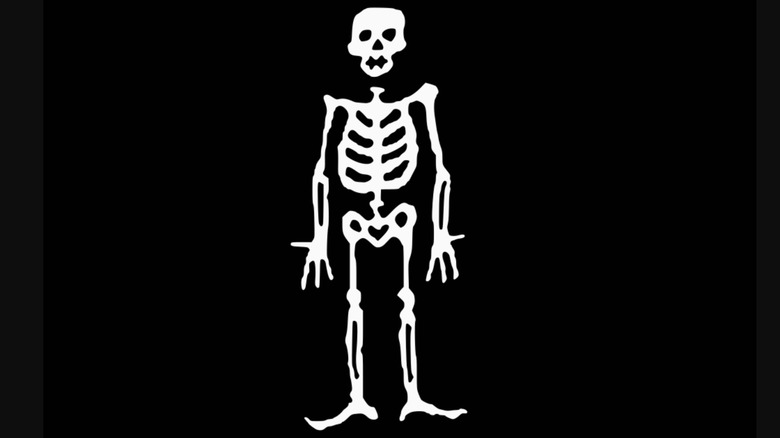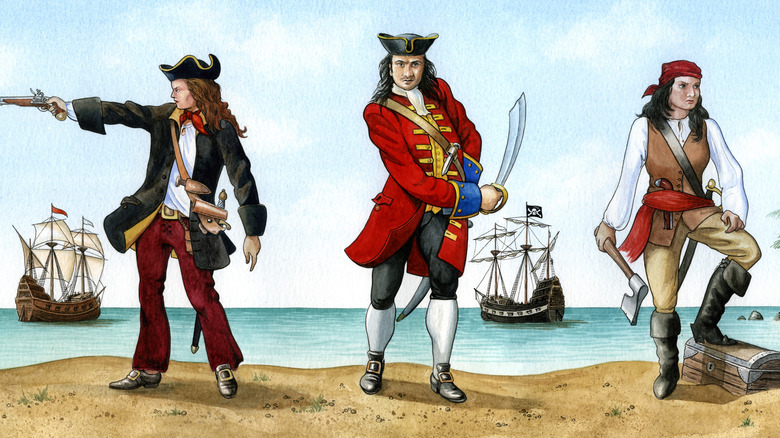The Most Famous Pirate Ships In History
A pirate captain is nothing without their ship. After all, without their ships, they are either land lubbers or marooned and doomed to a not-so-pleasant end. With that ship, however, they become something else entirely. They become fearsome kings of the sea, pillaging riches from whoever is so unlucky to possess them and sharing it among their crew with remarkable equality, as NPR points out. Such equality, in fact, that the pirate code became one of the first examples of working democracy in a world full of absolute rulers, according to Gary Chartier's "Pirate Constitutions and Workplace Democracy."
The thing is, most pirate ships didn't start out as pirate ships — they had other purposes. Some were built to transport enslaved people, some were simple merchant vessels, and some were even royal navy ships packed to the brim with cannons and ammunition. The thing with pirates is they took ships as often as they took riches, and if they found a ship they liked, they would make it their own, pad their own fleet, or burn it to avoid having to face it ever again.
But once a pirate captain really connected with his ship, there was little that could come between them. It was like an extension of themselves, fitted to the hand that steered it. While there are countless ships that flew the black flag, here are some of the most successful and famous ones.
Whydah
The Whydah is something of a unique ship in a lot of ways. Built in London in 1715 and destined to transport enslaved people, this 100-foot, 300-ton ship didn't have long for it's designed purpose. By 1717, it had found a new captain — one not so interested in the transportation of enslaved human beings, according to New England Today. On its maiden voyage, it crossed the path of Black Sam Bellamy, a pirate with a crew numbering in the 200s who had already been succeeding on the high seas for a year before coming across the vessel that he would transform into his flagship.
What made the Whydah so impressive was the speed — which was the preferred asset of pirate ships to allow for quick escapes. Bellamy had been using his career as a pirate to raise funds and marry the love of his life back home, but the pirate life got the best of his fancies. When it finally came time to return home, he and his 146 men aboard the Whydah were caught in a storm and shipwrecked off the coast of New England. Only two survived the wreck.
What makes the Whydah unique, however, is that the wreckage was recently recovered and turned into a museum along with large portions of the treasure lost in the wreck. According to New England Today, the hold of the Whydah contained the treasure of 53 ships — hard to argue with that success.
Queen Anne's Revenge
Surely everyone has heard of the infamous ship of the infamous pirate captain Blackbeard. There's a reason why this ship has such a reputation, and it ties in neatly with the reputation of its captain. Once known as La Concorde, the ship was built by the French to serve in the African slavery trade. It managed to avoid certain disaster for three years, transporting to and from the port of Nantes, but that avoidance didn't last forever (via the Queen Anne's Revenge Project).
Armed with sixteen cannons and a crew of 75 (via Queen Anne's Revenge Project), it wouldn't have been an easy mark, but Blackbeard saw his prize in 1717, and he took it. Having operated out of two smaller sloops in his early days, Blackbeard would have been thrilled to land a true flagship, and he rechristened it Queen Anne's Revenge and refitted it to house 40 cannons, according to World History Encyclopedia.
With this new ship, Blackbeard had all he needed to assert himself on the world stage. With a crew of 300-400, he was practically untouchable and would continue to raid and pillage as he saw fit aboard his prized ship for another year or so before he was finally captured and put to death, ending the era of one of history's most colorful characters.
The Ranger
What makes the Ranger unique is that it refers to a lot of different ships from many decades, but the most famous of them all likely falls to one man — Benjamin Hornigold, who assumed command of this mammoth in 1717 (via World History Encyclopedia). Hornigold was instrumental to the Golden Age of Piracy because it was his leadership that spawned the likes of Blackbeard and Sam Bellamy, both of whom had served under Hornigold aboard the Ranger. Blackbeard became Hornigold's second-in-command before Hornigold took the king's amnesty and gave up pirating. That, in turn, sent Blackbeard, Bellamy, and more scuttling to their own vessels.
When Hornigold became a pirate hunter, his primary target was Charles Vane, who, curiously enough, now captained his own sloop called, well, the Ranger, according to World History Encyclopedia. Vane eventually traded up to a brigantine that he renamed Ranger as well, making this quite the popular nickname. Whether Vane was doing this knowing Hornigold pursued him on a ship by the same name isn't clear, but what is clear is that the Ranger, whichever iteration you choose, had a big impact on piracy in the Caribbean. It's where some of the most famous pirates got their start, and it also ended up being a pirate hunter in its time as well.
Fortune
Not to be confused with Black Bart's Royal Fortune, the Fortune was an equally daunting ship of equally vast fortunes. Edward Low, the man who made the Fortune famous, had a bit of trouble keeping hold of a flagship. He captured numerous ships in his time, captained a bunch, and lost just as many. Among his captaining resume is the smaller vessel, the Rose, as well as an unnamed sloop, an unnamed brigantine, and an 80-ton schooner, just to name a few. But he really hit his heyday as captain of the Fortune, alongside another small vessel called the Ranger (not to be confused with all the other Rangers from years past), according to World History Encyclopedia.
Granted, Fortune's ascendancy also paralleled what we will call the deterioration of Low's mind. He was increasingly aggressive with Fortune and grew his fleet into a party of three, but while the pillaging of merchant vessels was still a fruitful endeavor, the downfall of Low came with attacking his own men, which violated practically every pirate code in existence. He was soon pegged to be mentally unwell and marooned on an island, promptly disappearing.
Whatever happened to Fortune after that is also a bit muddled, but she was a loyal 10-gun vessel that never questioned the slightly bent will of her captain.
Adventure Galley
The famed vessel of Captain William Kidd, the Adventure Galley is one of the few pirate vessels that was created under the same name it sailed under, even when it went from being a royal vessel to a pirate vessel. The Adventure Galley was top of the technological heap, capable of thriving in any conditions, according to the World History Encyclopedia. It boasted three masts, practically every sort of sail, and a bank of 46 oars, making it weatherproof. As for armaments, 34 cannons lined the ship, making it one of the deadliest vessels on the sea when it first set sail in 1696.
After a year of frustrated privateering, Kidd went full pirate in 1697, turning the Adventure Galley into a vessel of ill-repute. Some sources point to this being prompted by the fact that Kidd kept losing his original crew to illnesses, and the new recruits were far more often scoundrels than not. Perhaps seeing no other alternative, Kidd gave in to what the world seemed to want from him. Despite near-mutinies and numerous pillaging runs against merchant vessels, Kidd was always tied to the Adventure Galley, though he gave it up toward the end of his pirating career when the wood became too rotted and assumed command of a ship he had recently taken, renaming it the Adventure Prize.
Revenge
The Revenge is a truly one-of-a-kind ship because it was bought and paid for by the man who would go on to captain it — the gentleman pirate Stede Bonnet. Having undergone what must have been one of the most comprehensive midlife crises in the history of time, Bonnet gave up his wife and two kids and set sail to become a pirate, likely enchanted with the allure of the stories he'd been hearing around the Caribbean, according to Smithsonian Magazine. It's funny that he chose the name Revenge since, as the outlet points out, he didn't have anyone he was looking to get revenge on.
Regardless, Bonnet used Revenge to prop up a mildly successful pirating career, and it was the ship that took him to Blackbeard, at which point the two kicked off a friendship that history still debates. While injured, Bonnet handed over command of Revenge to Blackbeard, who had his own Queen Anne's Revenge serving him at the time as well, padding the growing fleet of the menacing pirate captain.
The end of Revenge is just as tragic as the end of Stede Bonnet. When relations between the two soured, Bonnet finally had reason to seek his ship's namesake, but after going ashore in North Carolina, he came back to find Revenge stripped of all goods. Bonnet reclaimed his ship and tried to hunt down Blackbeard but was captured and hanged before he got the chance.
Amity
One of the smallest ships on this list, weighing in at just around 70 tons, the sloop Amity was nothing if not well-traveled. Pirates certainly rotate vessels as needed and adjust according to their needs as a crew, but Thomas Tew, the renowned pirate from Rhode Island, held his seat aboard the Amity for quite some time, and all the way to the end of his piratical life. According to "'A Man of Courage and Activity'" Amity was very undersized for the journey she was intended for, across the Atlantic ocean from New England and into the Indian Ocean.
After setting out with another vessel, storms left Amity isolated, and not long after, Tew and crew decided to turn pirate and immediately set about raiding Mughal vessels in the Indian Ocean to great effect. They made quite a name for themselves and, as word traveled that the getting was good over by the Red Sea, more and more pirates flocked to the Amity's stomping ground. By 1695, a coalition of sorts had been formed in order to enact the greatest heist the world had ever known (via Mental Floss). Alongside Henry Every and The Fancy, Tew and the Amity engaged the Mughal fleet, but it was here that Tew and the Amity met their end, while Avery got away with the gold.
Royal Fortune
Like most other famous ships, the Royal Fortune was one of a kind for a completely different reason — it was just plain massive. According to World History Encyclopedia, Bartholomew "Black Bart" Roberts didn't go the route most pirate captains went when they opted for speed over power. Instead, he went for straight power, and the Royal Fortune had it, boasting 42-52 guns. Still, it's hard to track which Royal Fortune is which because Roberts continuously captured bigger and better ships while keeping the name the same. He upgraded to a new and improved Royal Fortune four different times throughout his pirating ventures.
The one he spent the most time on, though, was a French vessel built in 1697. This ship was just plain menacing, and it could hold its own against quite literally whatever it came across. Roberts had such success aboard one Royal Fortune or another that he was one of the notorious captains included in "A General History of the Pyrates," which details to a tee what he was able to do from his first Royal Fortune to his last. When his French ship broke down, he took on a new ship from the Royal Africa Company and worked 40 cannons into it, but that third iteration of the Royal Fortune, with all of its 52 cannons, remains the one that Roberts is most known for.
The Fancy
It takes a special pirate to make one big heist and be set for life, but it takes an equally special ship. For Henry Avery, that ship was The Fancy — a name that it more than earned. When Avery enlisted as an able-bodied privateer aboard the Charles II (via World History Encyclopedia), he probably didn't know what that ship would become to him. When the voyage never took form, Avery took matters into his own hands, mutinied, and took the ship for himself, rebranding it The Fancy and finding himself a natural leader with a really good idea.
You might say he was off to a good start as a pirate, and it only got better. In 1694 and 1695, he took his enterprising to the East African coast and pillaged to his heart's content aboard a ship that was just a cut above everyone else's. It was revered as one of the fastest on the sea and still managed to boast 46 cannons. He used that speed to pursue the Mughal treasure fleet and overtook them in just one night of pursuit, according to Mental Floss. Having left the coalition of pirates behind him and seeing as how no one could keep up, Avery took his chance, claimed his treasure, and promptly disappeared.
Whatever happened to him or The Fancy after that is unclear. He settled in the Bahamas, and there's no further record of either (via Smithsonian Magazine).
Golden Hind
It's hard to do much more as a ship than what the Golden Hind did. With Francis Drake in charge, the Golden Hind circumnavigated the globe, making ship and captain the first out of England to do so, according to the Golden Hind museum. Commissioned in 1577, the ship itself wasn't all that extraordinary — a 120-ton carrack that could reach high speeds and was easily steered by a capable captain. After the three-year journey around the world in which Drake accumulated countless riches — making him one of the most successful pirates of all time, even through the Golden Age of Piracy — the Golden Hind returned to England in 1580 and became the first-ever museum ship, being displayed proudly for 70 years. It was aboard that very ship, while on display in 1581, that Francis Drake was knighted.
The circumnavigation saw the end of every other ship in Drake's fleet, but the Golden Hind persevered and gathered a veritable hoard of gold, silver, and jewels from around the world. Most of which came from the mission given to Drake — a little casual raid against the Spanish treasure fleets in South America. Of course, the objective was never to circumnavigate the globe at all, but having amassed a reputation from his fight against the Spanish, they were waiting for him to make the trip back across the Atlantic (via Golden Hind Museum). So he didn't. He went the other way.
Happy Delivery
The Happy Delivery has something of a curious place in the annals of pirating history because when Captain George Lowther took command of the imposing vessel, he did what all captains do — he prepared a pirate code that all crewmen had to abide by, according to Owlcation. While this was standard practice, Lowther's code is one of the only pirate documents to survive into the present day and has been a massive piece in the puzzle of understanding the Golden Age of Piracy.
Of course, Happy Delivery is known for more than just a piece of paper. Perhaps the biggest victory in Happy Delivery's resume was an encounter with the Greyhound, a navy vessel. After an hour-long battle, Happy Delivery overwhelmed its adversary and had its way with it, with Lowther and crew pillaging it to their heart's content. The list of ships Lowther took while captaining this particular vessel is long, and it's largely devoid of large-scale conflict because of the power and reputation it held (via "A General History of the Pyrates").
Unfortunately for Lowther, his flagship would meet an unceremonious demise. While careening in the Gulf of Matique, the crew was attacked by natives and caught completely off guard. They scrounged what supplies they could onto a sloop that they weren't careening (also called the Ranger) and had to burn the Happy Delivery.
William
Captain John Rackham's ship, the William, has a unique claim to fame. Rackham really didn't accomplish all that much as a captain, save for a few small-time heists and one larger haul of the Kingston, according to the Crime Museum. Unfortunately for Rackham, the haul was too big, and it was what spurred the hunt to bring him to justice. After taking a pardon and going on his merry way, Rackham resumed his piratical ways alongside another famous pirate — Anne Bonny, who he had begun a love affair with. Together, they broke the pardon, stole the William, and went about being pirates again.
Rackham and the William boasted another first as well — he was the creator of the now-famous Jolly Roger, complete with skull and crossed swords, according to the Crime Museum. So no, the William doesn't have exploits like Queen Anne's Revenge or The Fancy, but it has other monumental contributions to the legacy of piracy in general.
